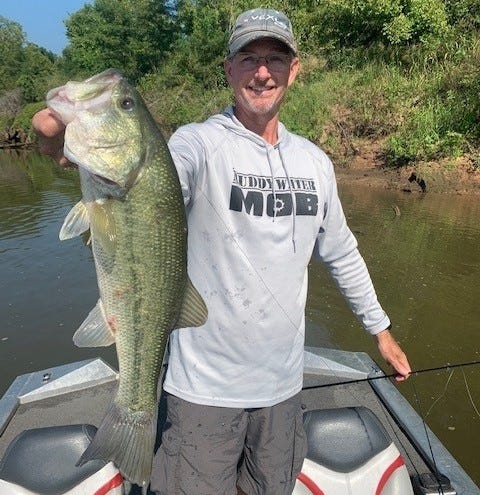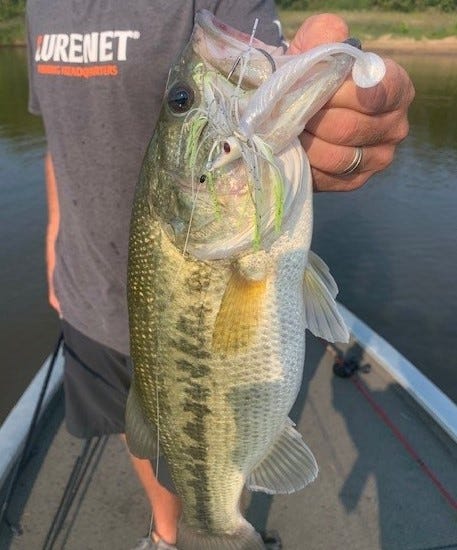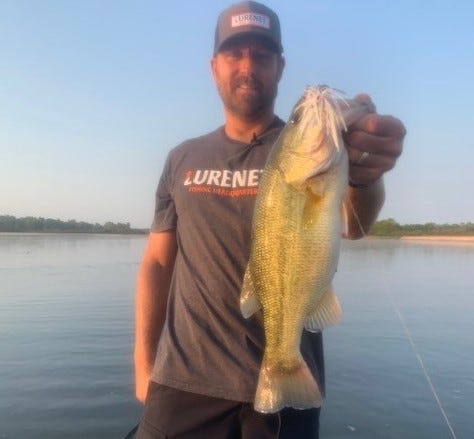- Nov 5, 2021
How to Fish a Swim Jig for Fall Bass
Learn winning swim jig strategies for autumn bass fishing from two anglers who have been swimming jigs for many years.
Fall is generally a disjointed time, with bait schools on the move and bass hot on their heels. Action can occur just about anywhere, so anglers need a bait that goes just about anywhere. For such autumn diversity, it’s hard to beat a BOOYAH Mobster swim jig.
“It’s always on my deck because I’m going to throw it around any piece of wood, any dock, any piece of cover that I think the fish may be relating to,” said Oklahoma pro Brent Haggard. “It’s such a huge part of fall fishing, I always have several tied on.”
Chad Warner, Director of Product Development for BOOYAH Bait Company agrees and notes that the swim jig easily earns a spot in his top 5 fall offerings.
“Number one, it emulates a shad so easily. Two, you can cover as much water as you could with a spinnerbait, a square bill, or any other shad profile. Number three, you can fish any kind of cover. Lastly, it’s the versatility of being able to fish it at different depths,” Warner said.
When a Swim Jig is Best


Haggard recalls learning this technique from his dad, who employed it on Lake Dardanelle and other fisheries in the 80s — way before swimming a jig became a thing. In the fall, he typically prefers higher clarity, because the fish are pushing shad balls, and the clearer the water, the better they can see the bait.
“I also like windy banks because the wind blows the bait up onto the bank and positions the fish behind ambush points like rock tips or the transition from gravel bank to a bluff,” Haggard said. “The fish will also get behind boulders, so you can throw to both sides to see which side the fish prefer.”
Warner also values good visibility, but he’ll readily capitalize on overcast/cloudy fall days because the low light allows him to fish his swim jig higher in the water column than he can during brighter conditions. Dirty water, like he commonly finds on the Arkansas River — or whenever wind stirs typically clear waters — creates a similar opportunity.
Swim Jig Targets
Warner devotes much of his fall attention to the backs of creeks and pockets, where he’ll throw the Mobster around every piece of hard cover he finds. Following a similar plan, Haggard’s fond of running his swim jig along laydowns. Using a YUM Chunk trailer for maximum water movement often triggers big bites.
Grass and swim jigs always go together like peanut butter and jelly, but Warner especially likes this bait when fall begins to unravel the edges of grass mats. The year-end die-off leaves pockets, lanes and isolated clumps where bass patrol for gathering shad.
Docks also produce well during fall, but Haggard finds most of his dock bites higher in the water column. Trailer choice plays a strategic role here.
“I generally throw the Mobster in shallow water, but I may throw it around a dock in 30-40 feet of water and let it fall 10-12 feet,” Haggard said. “On lakes like Grand or Tenkiller, those fish will suspend under docks, depending on where the bait’s at; so, I’ll throw it up there and let it fall.
“My main trailer for a dock would be a YUM Pulse, but if I’m throwing the Tommy Gun color, which looks like a perch, then I’ll use a YUM Spine Craw because I get a little more subtle movement. I also use that Spine Craw in grass, like water willow when the water’s clear and I don’t have to make a lot of commotion.”
Elsewhere, shad balls present a mobile target well worth pursuing, and Haggard finds his Mobster well suited for this duty. Casting to the bait schools and letting his swim jig fall below is a good way to pick off the fish that patrol beneath the activity and look for their chances to pick off easy meals.
“I’ll twitch my rod a little to make that skirt flare,” Haggard said. “A lot of times, I’ll throw the 3.5-inch YUM Pulse on the Mobster and, depending on the size of the bait, I’ll trim my skirt to make it compact.”
Mobster Specs & Rigging


Warner said he’ll break out a 5/16-ounce Mobster if he needs to slow down and float the swim jig presentation around shallow vegetation like water willow. His go-to, however, is the 1/2-ounce because he can fish it throughout the water column simply by adjusting trailer and retrieve speed.
“My standard trailer is a YUM Craw Chunk; nine times out of 10, that’s what I’m picking up to put on a swim jig,” Warner said. “For one thing, it has some really good action as you’re pulling it through the water. The pinchers will flap and create some really good commotion.
“I’ll use this trailer in clear water or dirty water. I can slow that bait down with that trailer or I can speed it up — there’s just not a lot of drag with that bait. If I need to fish the swim jig faster, I’ll go with a 3.5-inch YUM Pulse or a grub style trailer.”
Warner keeps his color simple: White and chartreuse color patterns, including the Cleaner and Shorty Small, are best when he’s targeting bait schools. The Fuzz, which is blue and black, with a green pumpkin Craw Chunk is his first choice for darker water.
Tackle & Tactics


Preferring a 6.8-7.3 gear ratio and 50-pound braid, Warner throws his Mobster on a 6-10 medium heavy to 6-11 heavy Falcon Expert Froggin/Pitchin rod. A fast tip helps with skipping the jig and enables him to impart the right action on a straight retrieve.
“I’ll do a lot short, precise casts, so that’s why I need that fast tip,” Warner said. “I always use a shake retrieve because I like to impart some action like a square bill. If I can make that skirt flare or make that jig vary its (movement), I feel like I can generate more bites. If I have sparse cover like water willow, I might burn it to get a reaction bite.”
Describing his retrieve adjustments, Haggard said, “I start out shaking my rod tip and if they’re just clobbering it, I might speed up my retrieve. If I’m having to feather that bait or leave it in the strike zone longer, I’ll shake my rod tip.
“When I’m throwing a swim jig down a laydown, most of the time, I’m just going to reel it back with a little bit of erratic movement; I never just throw it out there and crank it in. I’ll make some motion with my wrist because fish react to sudden movements.”
For his grass work, Haggard likes a 7-3 medium heavy rod with a stiff tip and 65-pound braid. He wants to know he can pull a good one out of heavy cover, but he wants just enough flex to avoid pulling the bait away from the fish.
“Occasionally, I’ll go to a 7-6 if I’m having to make really long casts,” Haggard said. “If I’m skipping a dock, I’ll use a 6-6 or 6-9 and either 15-pound fluorocarbon or 15-pound monofilament. The mono gives me more stretch and keeps me from jerking it away from them.”
Wherever he throws a BOOYAH Mobster swim jig, Warner offers this advice: “Let that fish turn. Similar to topwater fishing, I like swim jig fishing because it’s a visual bite. A lot of times, those fish will hit that bait out of aggression and an opportunistic bite, and you’ll see a lot of guys miss the bite because they set the hook too early.
“When you see that fish come up and eat that swim jig, give it a 2-count or a 3-count and let the fish turn sideways. Once they turn, you’re guaranteed to get a good hook set every time.”
Mobster Swim Jig
The BOOYAH Mobster Swim Jig utilizes a custom-designed head shape that slides effortlessly through thick cover and creates a lifelike swimming action. Features include a dual-wire keeper to hold trailers securely, even in the thick stuff, and a weedguard with optimal stiffness for staying out of snags but allowing for solid hooksets. It’s also equipped with a stout, ultra-sharp black nickel hook and a high-quality skirt. The Mobster comes in 5/16- and 1/2-ounce sizes, which are armed with a 4/O and 5/O hook, respectively.





